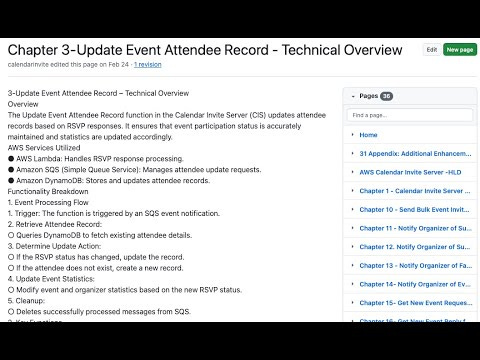FAQ’s -
What is the primary purpose of the "Update Event Attendee Record" function in the Calendar Invite Server (CIS)?
The "Update Event Attendee Record" function in the Calendar Invite Server (CIS) is designed to update attendee records based on their RSVP responses accurately. This ensures that event participation statuses are consistently maintained and relevant statistics, such as the number of attendees by status, are updated in real-time.
Which AWS services are utilized by the "Update Event Attendee Record" function?
The "Update Event Attendee Record" function leverages several AWS services to achieve its functionality:
AWS Lambda: This serverless compute service is responsible for processing the RSVP responses.
Amazon SQS (Simple Queue Service): SQS is used to manage and queue attendee update requests, ensuring reliable processing.
Amazon DynamoDB: This NoSQL database service stores and updates the attendee records and event statistics.
How does the event processing flow work when an RSVP is received?
An SQS event notification initiates the event processing flow for an RSVP. Upon receiving this notification, the function queries DynamoDB to retrieve existing attendee details. It then determines the necessary update action: updating the record if the RSVP status has changed, or creating a new record if the attendee doesn't exist. Subsequently, event and organizer statistics are modified based on the new RSVP status. Finally, successfully processed messages are deleted from SQS to prevent reprocessing.
What are the key internal functions involved in updating an attendee record?
Several key functions work together within the "Update Event Attendee Record" process:
lambda_handler(event, **): This is the entry point, iterating through SQS event records and calling process_request_from.
process_request_from(record): Extracts RSVP details, queries DynamoDB for the record, updates it and event statistics, and deletes the SQS message.
update_event_attendee_record_with(event_reply): Checks for RSVP status changes, updates existing records, or creates new ones.
get_current_attendee_record_for(event_reply): Queries DynamoDB to fetch an attendee's current status.
submit_updated_event_attend_record_for(event_reply, previous_status): Updates the attendee record and associated event statistics.
submit_shared_event_attend_record_for(event_reply): Creates a new attendee record specifically for RSVP responses from shared invitations.
delete_successfully_processed_sqs(message): Removes processed messages from the SQS queue.
How are attendee and event data stored and managed in DynamoDB?
In DynamoDB, attendee and event data are structured as follows:
Attendee Record: Stored with a pk (partition key) of event# and an sk (sort key) of attendee#. This record contains the attendee's RSVP status and historical information.
Event Statistics: This record tracks the number of RSVP responses categorized by their status (e.g., attending, declined, tentative).
What environmental variables are crucial for the function's operation?
The "Update Event Attendee Record" function relies on specific environmental variables for proper execution:
REGION: Specifies the AWS Region where the function is deployed and operates.
DYNAMODB_TABLE: Defines the name of the DynamoDB table used to store attendee records and event statistics.
SQS_URL: Provides the URL of the SQS queue dedicated to processing attendee update requests.
What measures are in place for error handling within this function?
The function incorporates several error-handling mechanisms to maintain robustness:
Invalid RSVP Requests: If a required field is missing in an RSVP request, the request is logged for review but skipped, preventing it from halting the process.
DynamoDB Update Failures: Failures during DynamoDB updates are logged for troubleshooting purposes, but they do not halt the entire execution.
Exception Logging: General errors and exceptions are logged to facilitate debugging and identify issues efficiently.
What is the overall benefit of this function for the Calendar Invite Server?
The "Update Event Attendee Record" function is crucial for the Calendar Invite Server (CIS) as it ensures that RSVP responses are accurately and efficiently reflected in the event database. By automating the update process through the intelligent use of AWS Lambda, SQS, and DynamoDB, the function maintains high data integrity, provides accurate event statistics, and streamlines the management of event participation, ultimately enhancing the reliability and user experience of the CIS.
AI Vid
This briefing document provides an overview of the "Update Event Attendee Record" function within the Calendar Invite Server (CIS) system, based on the provided GitHub Wiki excerpt.
Briefing Document: Update Event Attendee Record - Technical Overview
Source: Excerpts from "Chapter 3‐Update Event Attendee Record ‐ Technical Overview · calendarinvite/calendarinviteserver Wiki · GitHub"
Date of Source: February 24, 2025
1. Main Theme: Accurate Management of Event Participation
The core purpose of the "Update Event Attendee Record" function is to "ensure that event participation status is accurately maintained and statistics are updated accordingly" based on RSVP responses. This function is a critical component for managing event logistics and providing up-to-date information within the Calendar Invite Server (CIS) system.
2. Key Objectives & Functionality:
Processing RSVP Responses: The system is designed to process attendee RSVP responses efficiently.
Maintaining Data Integrity: It ensures that attendee records and event statistics are consistently accurate.
Automation: By leveraging AWS services, the process of updating records is automated.
3. AWS Services Utilized:
The function heavily relies on several AWS services to achieve its objectives:
AWS Lambda: This service "handles RSVP response processing," acting as the computational backbone for executing the update logic.
Amazon SQS (Simple Queue Service): SQS "manages attendee update requests," serving as a buffer and a mechanism to trigger the Lambda function when new RSVP responses are available. This ensures reliable message delivery and asynchronous processing.
Amazon DynamoDB: This NoSQL database "stores and updates attendee records," providing a scalable and highly available data store for all event and attendee-related information.
4. Functionality Breakdown (Event Processing Flow):
The process for updating an attendee record is clearly defined:
Trigger: The entire process is initiated when an "SQS event notification" is received, indicating a new RSVP response needs to be processed.
Retrieve Attendee Record: The system first "queries DynamoDB to fetch existing attendee details" to determine if the attendee has a prior record.
Determine Update Action: Based on the retrieved record and the new RSVP status:
If the "RSVP status has changed," the existing record is updated.
"If the attendee does not exist, create a new record."
Update Event Statistics: Crucially, the function "modify[ies] event and organizer statistics based on the new RSVP status" provides real-time insights into event participation.
Cleanup: To prevent reprocessing and maintain queue efficiency, the system "deletes successfully processed messages from SQS."
5. Key Functions (Software Components):
The technical overview highlights several key functions within the system:
lambda_handler(event, **): The entry point for the Lambda function, it "iterates through each record in the SQS event" and calls process_request_from.
process_request_from(record): This function is responsible for extracting RSVP details, querying DynamoDB, updating records/statistics, and deleting messages from SQS.
update_event_attendee_record_with(event_reply): Checks for RSVP status changes and either updates an existing record or creates a new one.
get_current_attendee_record_for(event_reply): Specifically queries DynamoDB for an attendee's current status.
submit_updated_event_attend_record_for(event_reply, previous_status): Handles the actual update of the attendee record and event statistics.
submit_shared_event_attend_record_for(event_reply): Creates a new attendee record for responses from shared invitations.
delete_successfully_processed_sqs(message): Ensures messages are removed from SQS after successful processing.
6. Data Handling (DynamoDB Records):
Attendee Record: Stored with a composite key:
pk: event#<event_id> (partition key)
sk: attendee#<attendee_id> (sort key)
"Stores attendee RSVP status and history."
Event Statistics: "Tracks the number of RSVP responses by status," providing aggregate data for event organizers.
7. Environmental Variables:
The function uses specific environment variables for configuration:
REGION: The AWS Region where the function executes.
DYNAMODB_TABLE: The name of the DynamoDB table used for storing records.
SQS_URL: The URL of the SQS queue for processing attendee updates.
8. Error Handling:
The system incorporates robust error handling to maintain stability and aid in debugging:
Invalid RSVP Requests: If "a required field is missing, the request is logged and skipped," preventing individual malformed requests from halting the entire process.
DynamoDB Update Failures: These are "logged for troubleshooting but do not halt execution," ensuring resilience in the face of database issues.
Exception Logging: All errors are logged to "facilitate debugging."
9. Broader Context (Related Functionality):
While this document focuses on Chapter 3, the provided table of contents for the GitHub Wiki reveals that this function is part of a larger, comprehensive "Calendar Invite Server (CIS)" system that manages various aspects of event creation, invitation, notification, and reporting. Other related chapters include:
"Chapter 19 ‐ Create New Event Record ‐ Technical Overview"
"Chapter 7‐ Send Event Invite ‐ Technical Overview"
"Chapter 26 ‐ Get Event Attendee Report ‐ Technical Overview"
This indicates that the "Update Event Attendee Record" function is a crucial piece of a broader event management ecosystem.












